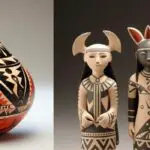I confess I am a pretty big history nerd. And there’s a significant marriage between art and the past (which is great for me).
Greek culture has a long reach, affecting everything from sports to philosophy. Art (and particular ceramics) is no exception. Some of the most celebrated ceramic pieces are Greek pottery.
Today, we’ll take a closer look at ancient Greek pottery and its implications for today.
Ancient Greek ceramics – a timeline
Greek ceramics date back all the way to the Stone Age with defining moments along the way. Let’s look at what we know about ancient Greek ceramics.
The first discovered pieces
The earliest known Greek pottery pieces are dated somewhere between 7,000 – 3,500 B.C. Modern-day Greece’s eastern shoreline is along the Aegean sea. Many ancient Greek pieces are named according to this body of water. So when you’re looking up ancient Greek pottery you’ll likely see the word “Aegean”.
The earliest found ceramic works have been discovered in Asia. You can read about part of the region in our Japanese pottery piece at the link.
Mediterranean pottery during the Stone Age is primitive and solely for practical use (thinking of eating utensils and storage). But the clay and dyes used are there that go on to define Greek pottery. The clay most Greek pottery is made out of is an iron-rich red clay often referred to as attic clay.
Introducing geometric decorations
Greek pottery really picks up in the Bronze Age. Most of the pottery from the region came from the eastern side of the Mediterranean. In particular, the Peloponnese region became a leader in ceramic production.

About this time, a new style of decorating pottery started popping up called Sesklo ware. Sesklo ware uses geometric decorations which is a hugely celebrated part of Greek culture.
Ancient history is often bookmarked by war and conquest. Ancient Greece went through a lot of both during the Bronze Age. With conquest came new inventions. The potter’s wheel brought about new styles and quicker production. And by the end of the Bronze Age, Greek culture was solidifying and Greek pottery was flourishing.
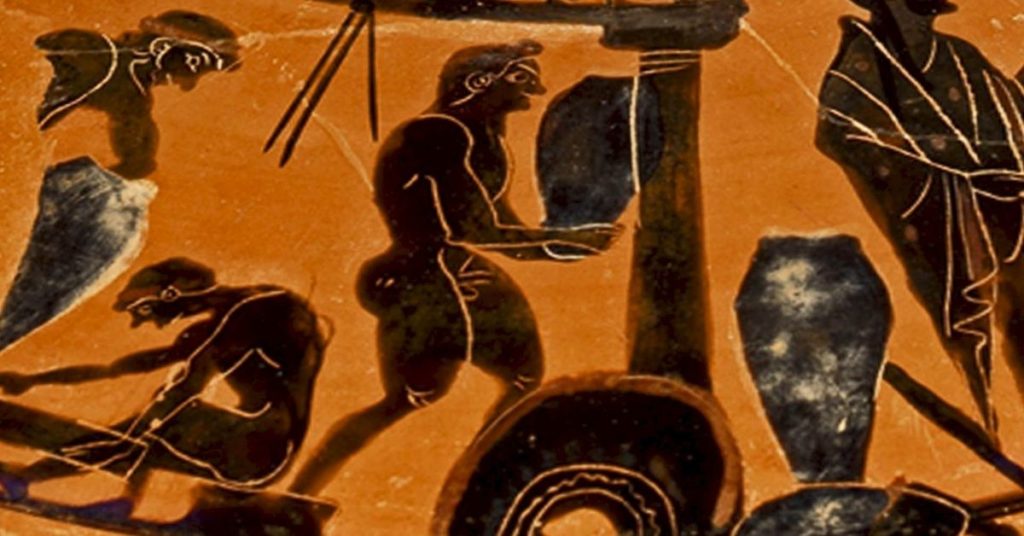
A setback – the Dark Ages
While some conquests led to new inventions and styles, the conquest that instigated the Greek Dark Ages was a setback for culture. Greece was conquered by a primitive population from the north called the Dorians. During this time, Greek art was lost and destroyed, and the arts scene fell apart.
Our of the Dark Ages, Athens rose up to become a governmental and cultural hub.
A defining style in Greek Pottery – the post-Dark Age years
The Dark Ages ended and ushered in a cultural and arts revolution. Quickly, the geometric style became the most appreciated decoration style in Greek culture.
Ceramic artists held each other to higher and higher standards. Style shifted from lines and patterns to animal and human forms in increasingly life-like ways. In fact, many pots are historical records. Ceramicists were commissioned to record important historical events through decoration.
Another development in Greece was the “Oriental Style” after trade opened up between Greece and Asia.
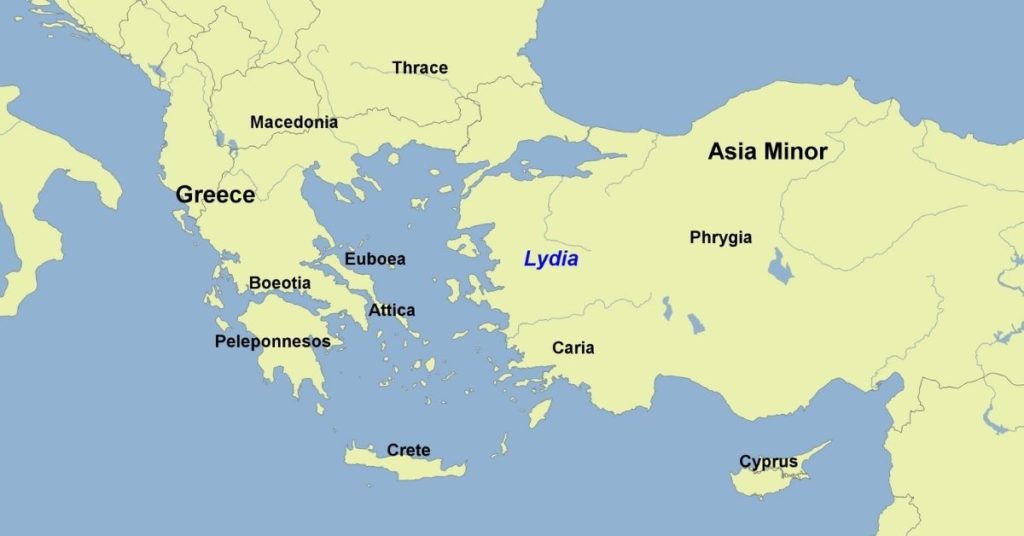
The style resulted in beautiful mash-ups of Greek and Middle Eastern artistic styles. The pieces featured a variety of animals, flora, and sophisticated patterns.
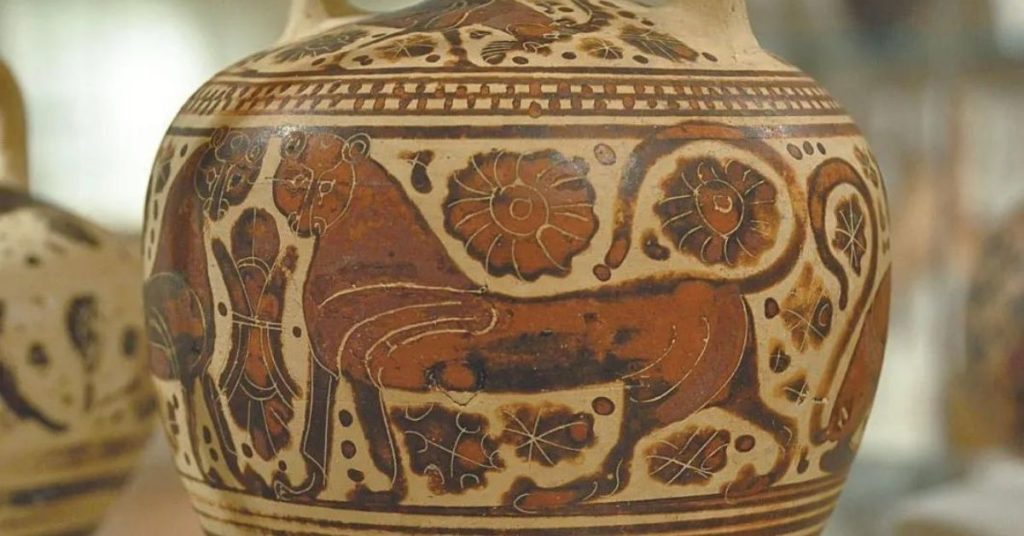
What technology did the Greek potters have?
Most Greece pots that have stood the test of time and are well-known to us now were created on a potter’s wheel. Like many cultures, ancient Greek pottery would have started with simple tools and hands to create wares. The technique to create ceramics without a wheel is called handbuilding pottery and the most common handbuilding technique used by the Ancient Greek potter was the coiling method.
But wheel-thrown Ancient Greek pots have been discovered as early as 2,500 B.C.E. That’s pretty early when compared to other cultures.
The pottery wheels used during ancient Greek days would have been human-powered. The most common wheel was a kick wheel which is powered by the potter’s legs. The wheel was made of stone, wood, or even ceramic.

The wheel would have changed the game for the Greeks. Wheel-thrown pots have many advantages over hand-built pots. For instance, the potter can create a wheel-thrown pot much faster and maintain consistency. With new technology, cities became art hubs and pottery could be produced quickly in large numbers by a single artist. With mass production, pottery was included everyday use for even commoners.
Greek pottery types and styles
Next, let’s take a look Greek pottery designs that have come to define the period and region. We’ll talk a bit more about history, but mostly dig into examples and share pictures.
Geometric pottery
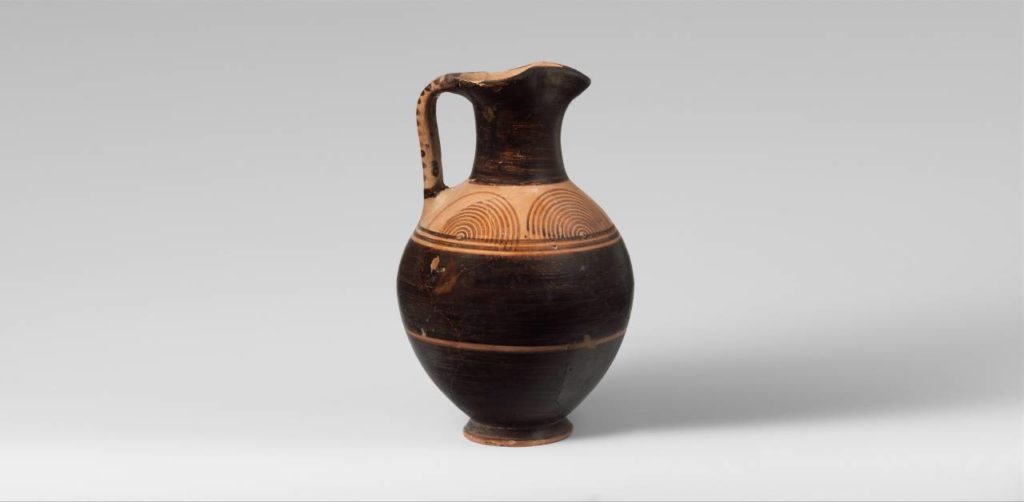
The geometric style is a painted style popularized by the Greeks. Horizontal lines would be painted around the circumference of the vessel. Then geometric designs would be interwoven between and through the horizontal lines.
Greek pottery vase patterns are divided into zones with equal spacing giving the pot a symmetrical appearance.
Check out our article “5 incredible pots with geometric decorations” to see some of these gorgeous ancient works with their geometric shapes.
Corinthian pottery
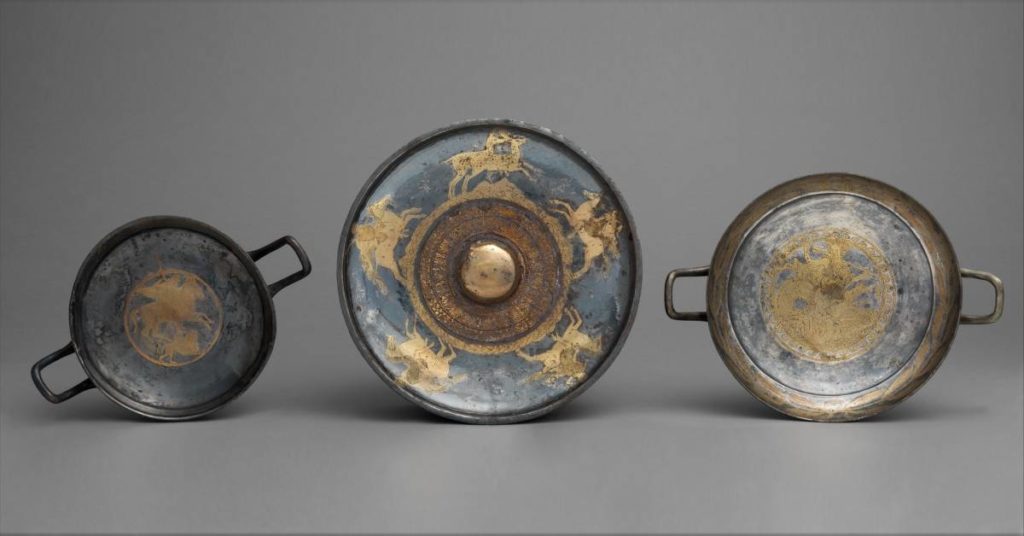
Corinthian pottery had heavy influences from the design style of the Middle East. Corinth became the hub of pottery activity after the Greek Dark Ages. At about the same time, trade opened up through Asia Minor leading to a unique mash-up of Greek and Middle Eastern artistic styles.
Designs in this Greek pottery style feature a variety of animals, flora, and sophisticated patterns.
Black-figure pottery
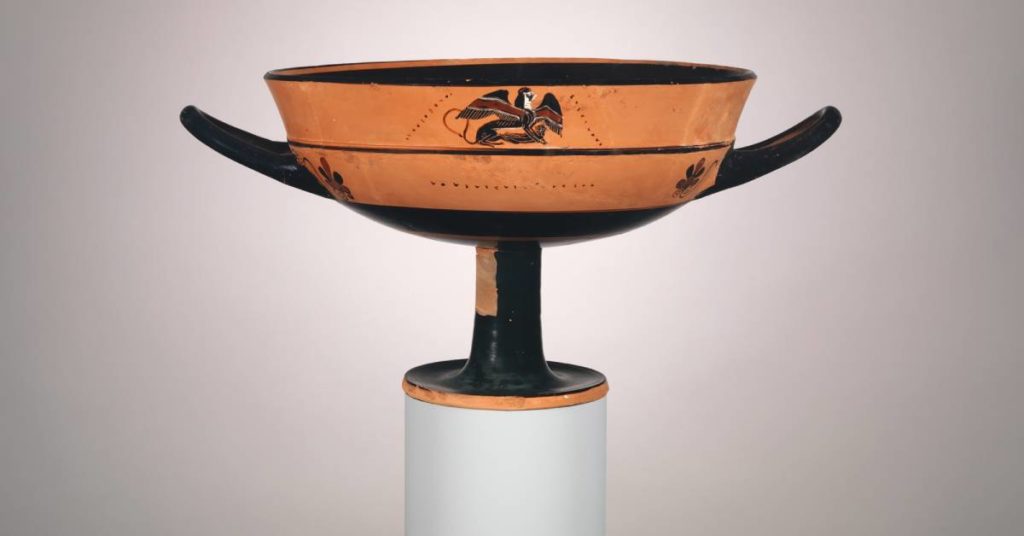
Black figure pottery painting was first introduced in Corinth (they did a lot for pottery in Corinth!). The artist would paint designs and figures in black on the red surface of a vessel.
The black-figure style allowed for painting animal and human figures on the face of ceramic works. Figures were typically silhouetted due to the contrasting colors. It also led to some of the first artists that we know by name.
If you’re looking for more on this subject matter, check out our article “How the Ancient Greeks made black-figure pottery“.
Red-figure pottery
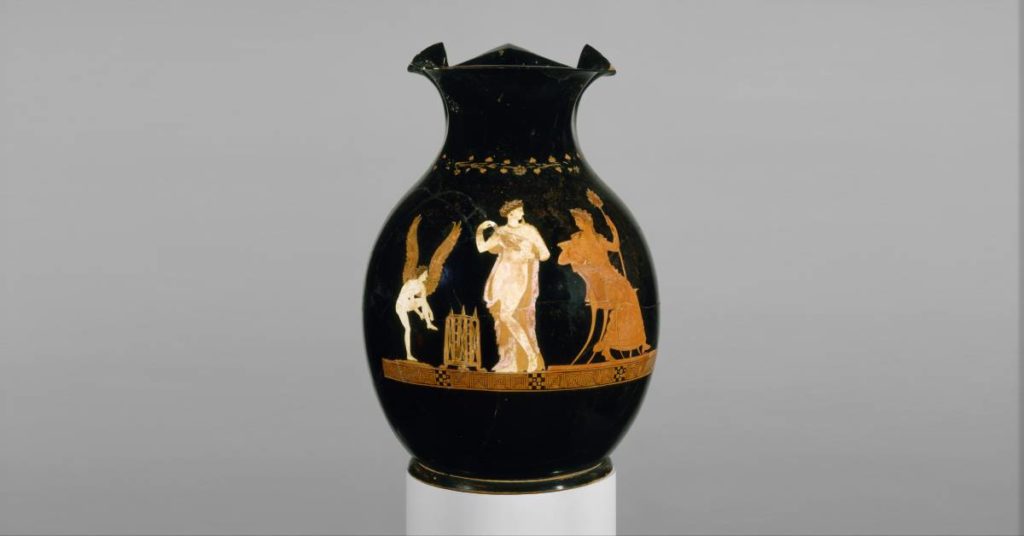
The red-figure pottery painting style is an ol’ switcharoo from the black-figure pottery. An artist would paint designs and figures in red on a black background. Often the designs were scenes or the human form or representative of Greek mythology.
A few decades after black-figure painting took Greece by storm, the red-figure style replaced it. The red-figure technique was popular domestically and internationally.
Archeologists have discovered red figure pots from Greece in Southern Italy and even further north into Europe.
Traditional ancient Greek pottery shapes
If you’re like me when I started in art history, you probably think a vase is a vase and a bowl is a bowl. But if you’re ever looking at ancient Greek pottery, you’ll probably come across specific terms used for the vessel shape.
Pottery played a central role in Greek life. From how food and drink were served to what was included during a funeral service. Let’s take a quick look at the different styles from storage vessels to funerary vases. The diagram below from The Museum of Art and Archaeology demonstrates the form of each of the pottery vessels. And the table below has the different pottery shapes listed alongside their uses.
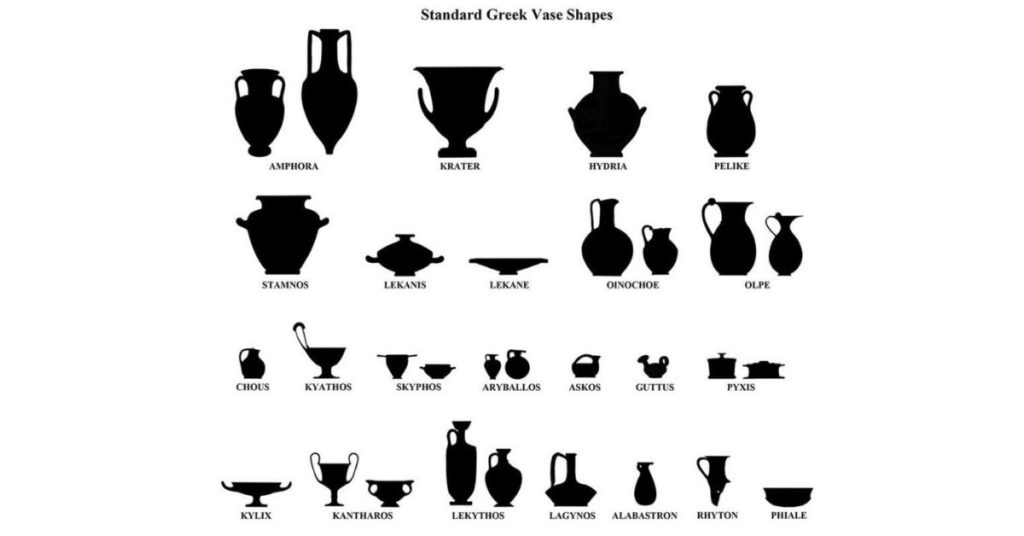
| Name | Style | Use |
|---|---|---|
| Alabastron | Elongated neck. Small enough to hold in one hand. | Scented oils and perfumes. |
| Amphora | Two-handled jar. Typically is tall with a narrow neck. | Food and liquid container. Sometimes used to hold the ashes of the deceased. |
| Aryballos | Small spherical container with a narrow neck and a wide mouth. | Scented oils and perfumes. |
| Hydria | Three-handled jar – two on the sides and one in the back. A wide and tall body with a narrow neck for better pouring. | Most commonly for holding and serving water. |
| Krater | A wide-body with a large, lipped mouth. The body typically narrows to the base. | Diluting wine with water. |
| Lekythos | One handle. A round body with an elongated neck that ends in a wide mouth. | Stores oil for ceremonial moments – funerals and religious events. |
| Loutrophoros | Two-handled. A round body with an elongated neck that ends in a wide mouth. | Stores water for ceremonial moments such as a funeral or a bridal bath. |
| Oinochoe | A single, curved handle. Small base transitions to a round body. The mouth’s lip is on one side like a pitcher. | A wine pitcher. |
| Olpe | Similar to an oinochoe with a narrower, cylindrical body. | A wine pitcher. |
| Pelike | A two-handled vessel without a neck. Typically with a round body and a wide mouth. | Storing and serving liquids. |
| Psykter | A narrow base with a bulbous body. | Used for chilling wine by resting the vessel in ice or chilled water. |
| Pyxis | A cylindrical shape with a top. The top has a pointed handle. | Jewelry box. |
| Stamnos | A two-handled vessel without a neck. Typically with a round body, a wide mouth, and a lid. | Storing liquids. |
Conclusion
Greek culture has defined the world as we know it. And pottery is no exception. Greek pottery has a lot to offer with beautiful designs, various types of ceramics, and incredibly rich history. The Greeks discovered and innovated a great deal of new pottery styles and forms through different time periods leaving quite the archaeological record for us to track.
The black-figure technique, red-figure technique, geometric designs, and the different shapes of Greek vessels are hallmarks of the classical period and have left a legacy that has wowed potters and art lovers alike.
If you have any questions or comments, please email us at hello@wheelandclay.com. We’d love to hear from you! If you’re not a history nerd, thanks for indulging me.
Related articles
5 incredible pots with geometric decorations
How the Ancient Greeks made black-figure pottery
A guide to ancient Mayan pottery



